|
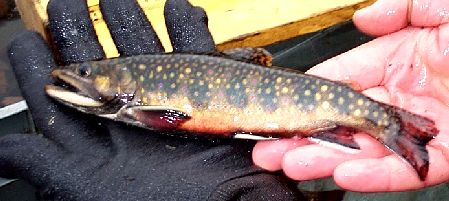 Honnedaga Lake brook trout
Honnedaga Lake brook trout |
Endemic to the eastern United
States, brook trout Salvelinus fontinalis were historically
so common in the Adirondack region of New York State that early
fish surveys noted the absence of brook trout from lakes and ponds,
rather than their presence. Humans -- by constructing dams, over-fishing,
introducing non-native fishes, logging, and acidifying waters --
have caused such a disruption in brook trout habitat and community
structure that this native trout has disappeared from a wide variety
of lakes, rivers and streams. Over the past 20 years, however, improved
management practices have restored many previously degraded brook
trout lake fisheries to a healthier condition. |
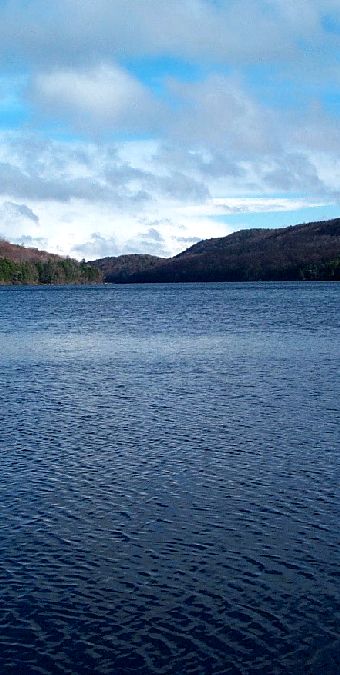 Honnedaga Lake
Honnedaga Lake
|
From a conservation perspective, the
nine remaining "heritage" strains of brook trout in New York are
particularly noteworthy. Heritage populations are wild strains
of brook trout that maintain the original genetic characteristics
of a specific lake population. Heritage strains have survived
despite widespread introductions of hatchery-reared brook trout
varieties, and exist only within waters where genes from outside
the original population have never been introduced into the subject
lake. Keller (1979) identified ten heritage varieties of wild
New York brook trout: Basalm Lake, Dix Pond, Honnedaga Lake, Horn
Lake, Little Tupper Lake, Nate Pond, Stink Lake, Tamarack Pond,
Tunis Lake, and Windfall Pond. Unfortunately, the Tamarack Pond
variety was lost in the early 1990s, and the Honnedaga Lake population
declined dramatically during the 1970s. In recent years, however,
the Honnedaga Lake population has shown signs of recovery. Cornell's
Adirondack
Fishery Research Program is currently evaluating and attempting
to enhance the recovery of the Honnedaga Lake brook trout population.
(back to top)
Recovery
of an Acid-Stressed Brook Trout Population in
Honnedaga Lake: Preliminary Assessment of Water Quality, Population
Size, and Population Genetics
(Clifford Kraft and Daniel Josephson)
Honnedaga Lake is
a large (770 acre), deep (max depth 184 feet), and highly transparent
(secchi depth 75 feet) body of water. The unique color of the
water (light blue), high zinc levels, and low pH are also defining
features of this lake, located in the southwestern Adirondack
Mountain region.
Brief
History of the brook trout fishery in Honnedaga Lake 1900-1970:
At the turn of the 20th century, Honnedaga Lake supported a recreational
fishery for a self-sustaining population of brook trout. Early
records are sketchy; however, it appears that the brook trout
population was supported by natural reproduction through the 1930s.
In 1939, a hatchery-based stocking program was initiated using
fry and fingerlings that originated from adult Honnedaga Lake
brook trout, and remained active until 1968. Substantial trapnet
catches of brook trout (range 24-80 fish/trapnet night) were observed
from 1958 through 1966, at which time modest angling catches were
also reported.
|
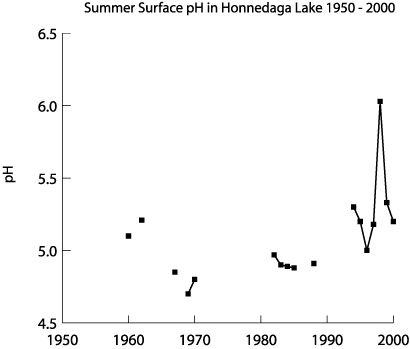 |
|
Although little
water chemistry data was collected prior to 1970, available date
indicate that Honnedaga Lake exhibited low pH (range 4.3 to 6.0),
alkalinity (0 to 6.5 mg/l), and ANC (Acid Neutralizing Capacity;
0 to 130 µeq/l) by the late 1950s. The presence of brook
trout through the 1960s suggests that water chemistry conditions
remained suitable for brook trout survival until a marked decline
was observed during the late 1960s. Between 1900 and 1960, introduced
populations of white suckers, round whitefish, and lake trout
also disappeared from the lake, suggesting that deteriorating
water quality conditions occurred prior to the 1960s. This decline
was likely due to inputs of airborne pollutants now known as acid
rain.
(back to top)
|
1970-1993:
By 1970, the water chemistry of Honnedaga Lake had deteriorated to the
point where fish survival was not possible. The observed pH (range 4.80
to 5.00), alkalinity (-6 to -8 mg/l), and ANC (-120 to -160 µeq/l)
values indicate that chronic acidification was evident. During this
period, few brook trout were observed in Honnedaga Lake. The last angling
catches of brook trout were reported in 1971 and 1972, and trapnet catches
declined from 7 fish per trapnet night in 1971 to only 0.7 fish per
trapnet night in 1979. The brook trout stocking program was terminated
in 1968 due to low survival of stocked fish, and direct observations
of brook trout in the main lake were rare during the next two decades.
During this period, brook trout only continued to be observed in low
numbers in three small tributaries fed by groundwater sources.
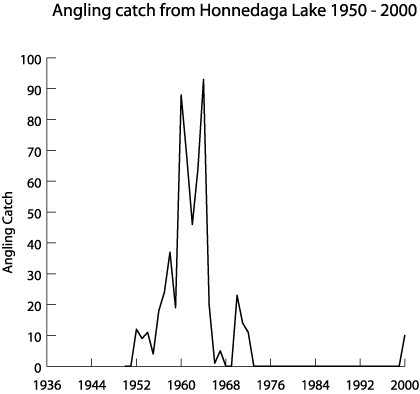 |
|
1994-2000:
Little attention was paid to the Honnedaga Lake fishery during
the late 1980s and early 1990's, and data collection was sparse.
Chronic acid conditions in the lake water left few options for
restoring the brook trout population. By the mid 1990s, however,
lake property owners reported several observations of brook trout
in the lake, and a few dead fish washed up on the shoreline. In
fall 2000, large schools of brook trout were noted by one angler.
In response, a trapnet was set in November 2000 near a tributary
of the lake, resulting in a catch of 70 fish (23.3 fish/trapnet
night) ranging from 8-18 inches in length. The trapnet catch indicated
that at least 3 or more year-classes of brook trout were present
in the lake.
Water chemistry data collected from 1994
to 2000 indicates that conditions may have improved for brook
trout survival in the lake. Modest improvements in pH (range 5.00
to 6.03) and ANC (-2.32 to +7.25 µeq/l) have apparently
been sufficient for brook trout to recolonize and survive in the
lake. We suspect that the recently observed lake population of
brook trout resulted from recolonization of the lake from small
tributary populations that survived in isolation for nearly three
decades.
(back to top)
|
|
The year 2000 was a turning point for
the brook trout fishery and water quality of Honnedaga Lake. An
upward trend in pH, the presence of adult fish in the lake, and
the first reported angler catch of brook trout in nearly three
decades provided evidence that improvements had occurred in Honnedaga
Lake. In 2001, an assessment program was established to assist
in evaluating the recovery of the brook trout fishery. Seasonal
water quality and brook trout abundance in the lake and its tributaries
are now measured from May through November. The following results
provide information about the status of the Honnedaga Lake brook
trout population and the lake's environment.
(back to top)
|
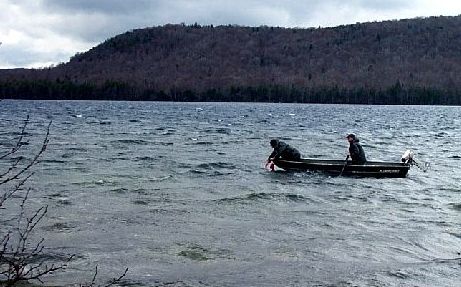 Tending a trapnet in Honnedaga Lake
Tending a trapnet in Honnedaga Lake |
INITIAL RESULTS
I. Water Quality Surveys
Water quality surveys have been conducted at two deep sites
in the lake and ten tributaries during 2001 and 2002.
Tributary water quality
Water quality was variable across tributaries, indicating that
some were influenced by groundwater inputs while others were primarily
influenced by surface run-off. Groundwater-influenced tributaries were
less acidic than those tributaries influenced by surface run-off. The
pH range across tributaries was 4.5-6.6.
Lake Water Quality
Water chemistry was fairly uniform from the surface to the bottom of
the lake. The lake was characterized by low pH and low ANC throughout
the May and August period. Although improvements in water quality were
evident, Honnedaga Lake continues to be extremely susceptible to acidification
from airborne pollutants. As the pH of the water has increased, heavy
metals (such as aluminum and zinc) have likely become less soluble and
hence less concentrated in the water column. At present, fish are likely
surviving in the lake due to reduced levels of toxic metals in the water
column resulting from an increase in pH above 5.0 (range 5.0 - 5.6).
II. Brook Trout Population Surveys
Slightly less than 250 brook trout have been captured during late
October and November trap net surveys during 2001 and 2002. Captured
brook trout ranged in length from 4 to 20 inches, yet 74% of the fish
caught were smaller than 12 inches. A wide range of size classes (and
likely age classes) are present in Honnedaga Lake, indicating that brook
trout have likely been successfully surviving and spawning in the lake
and its tributaries for several years.
Future Evaluation
A recovery of the Honnedaga Lake brook trout population is underway.
Establishment of a long-term water quality and fish population monitoring
program will ensure that effective actions can be implemented to aid
the restoration of the population.
(back to top)
|


